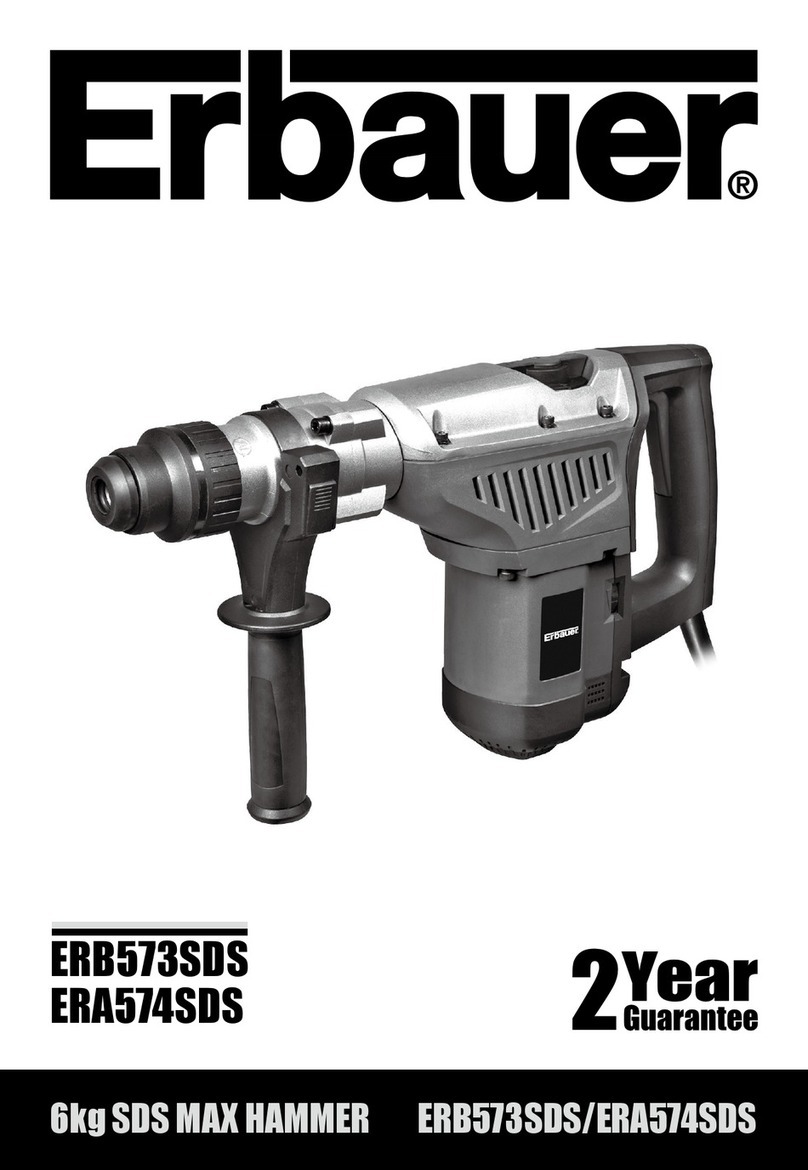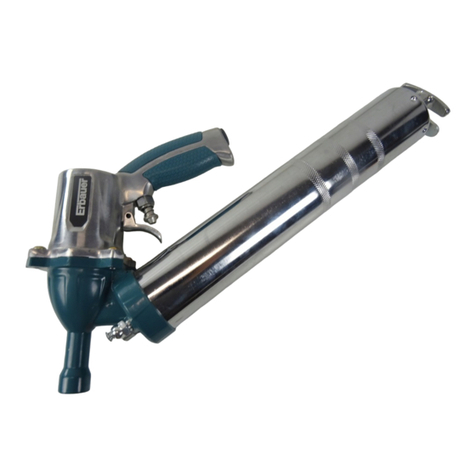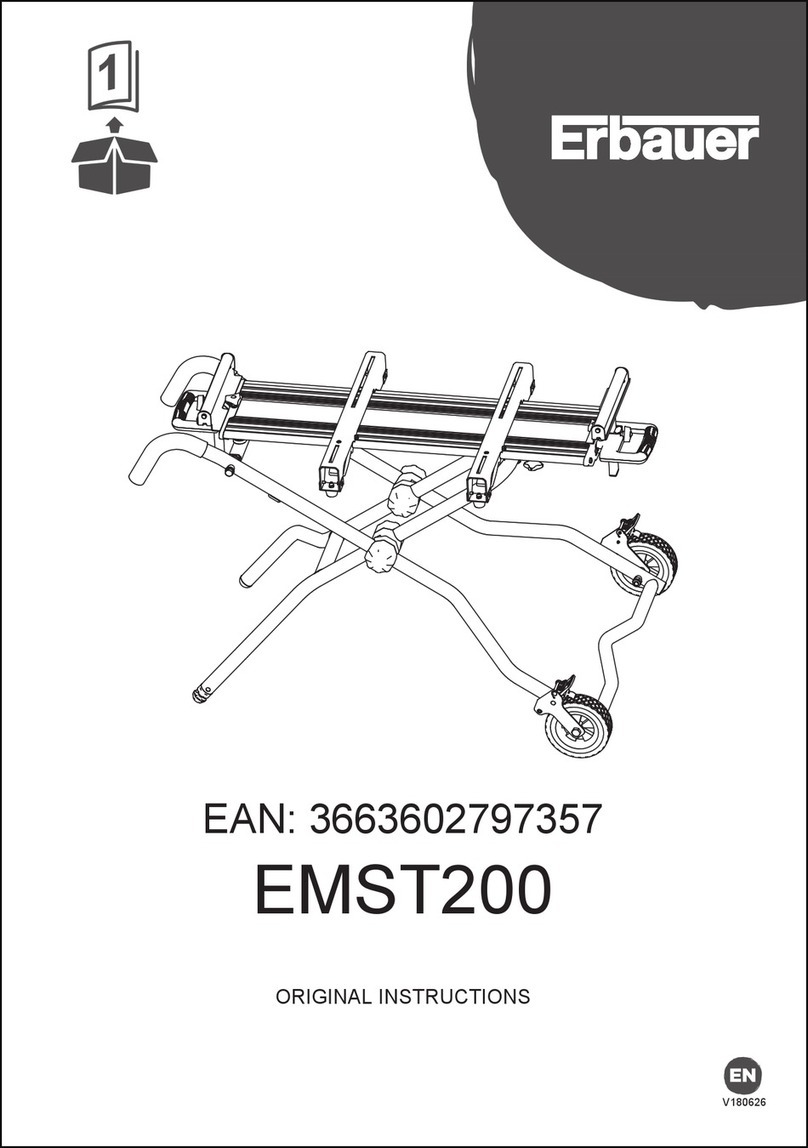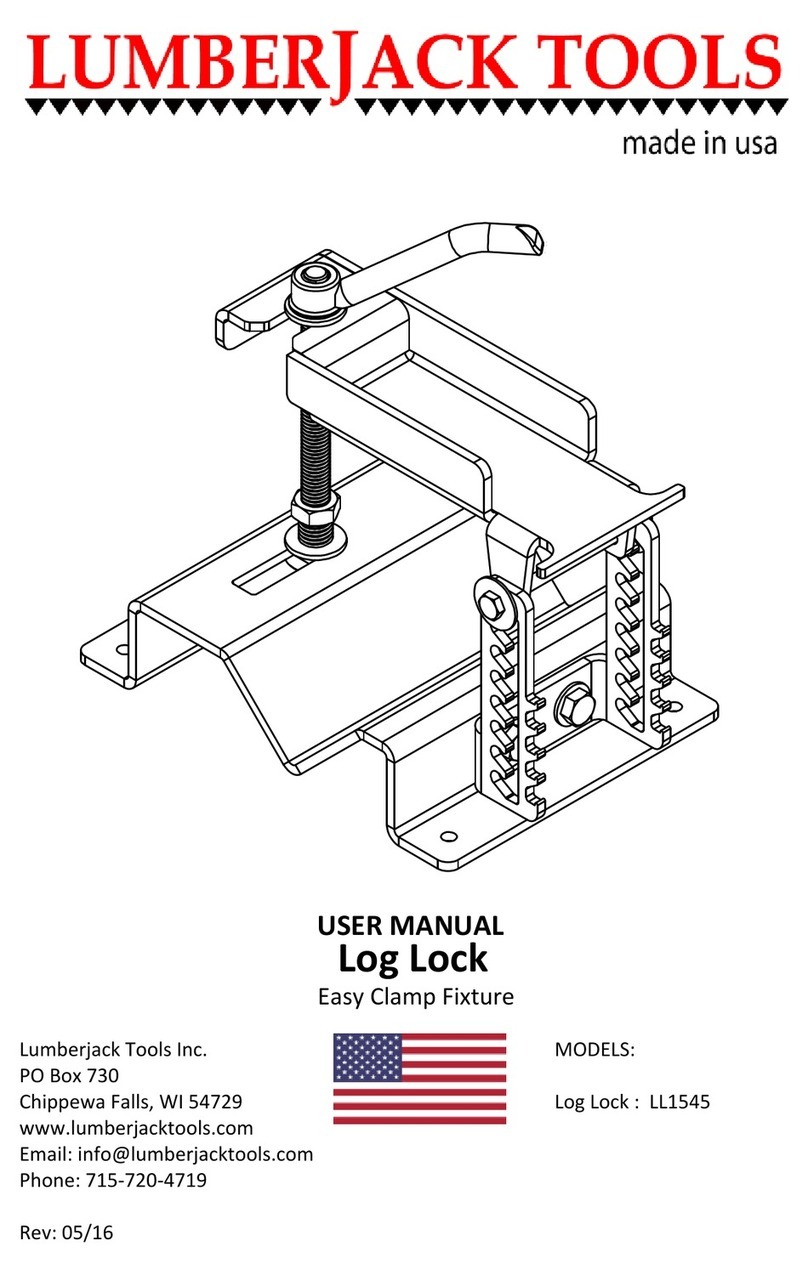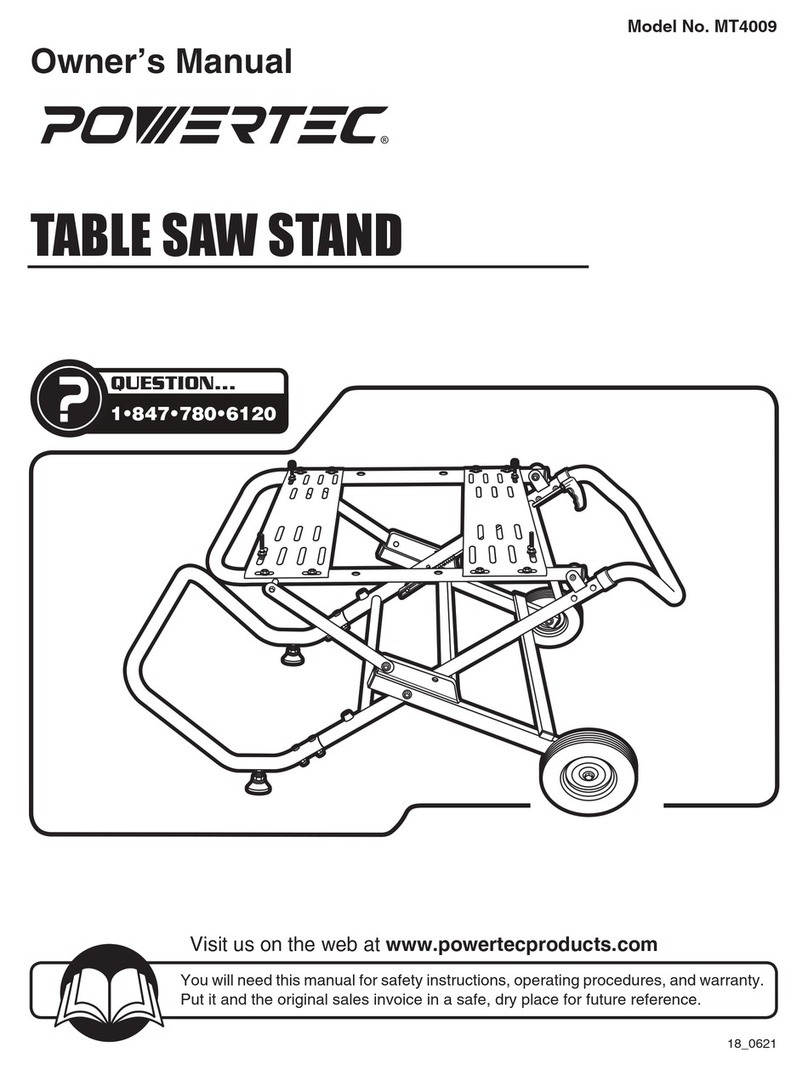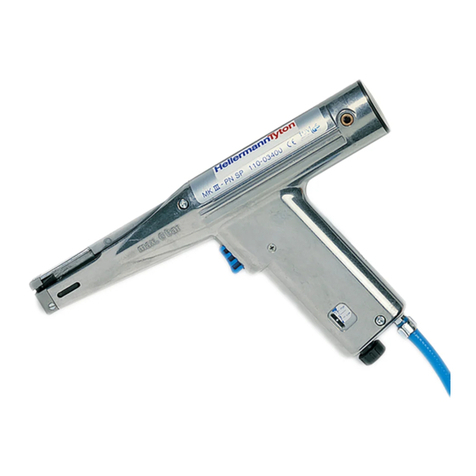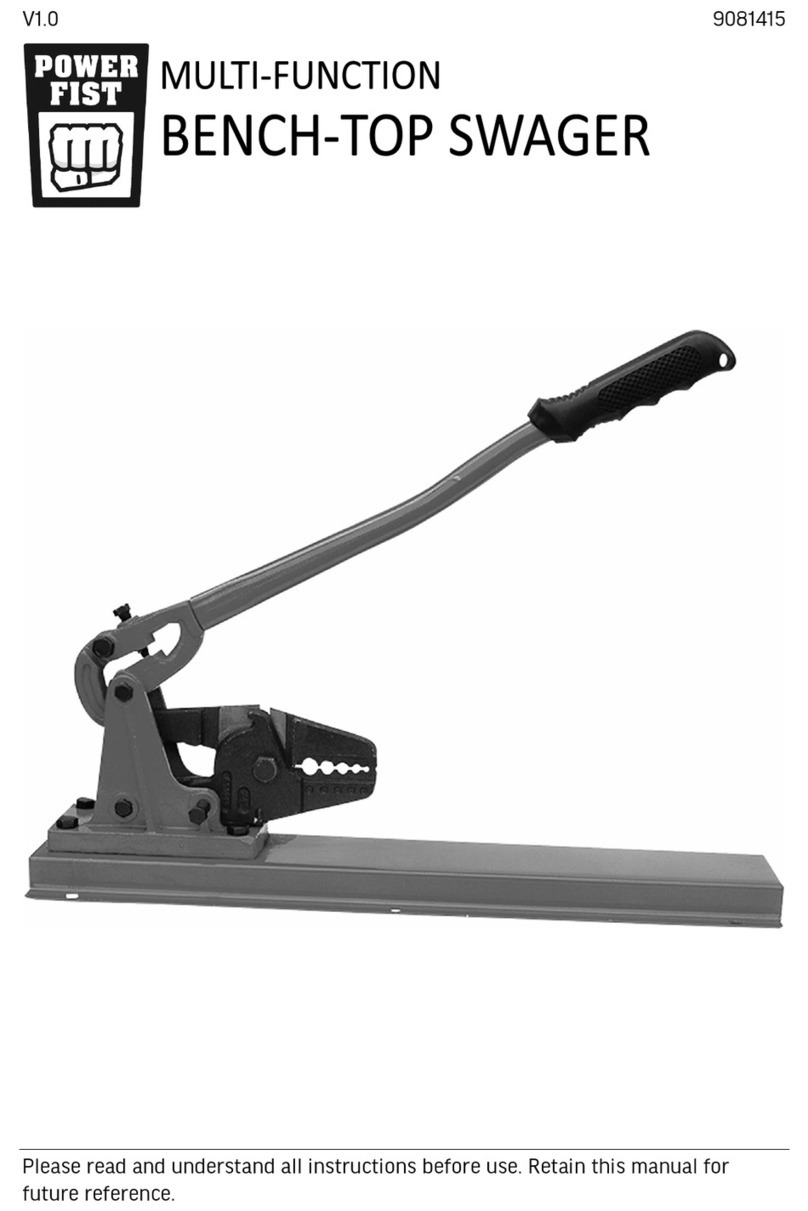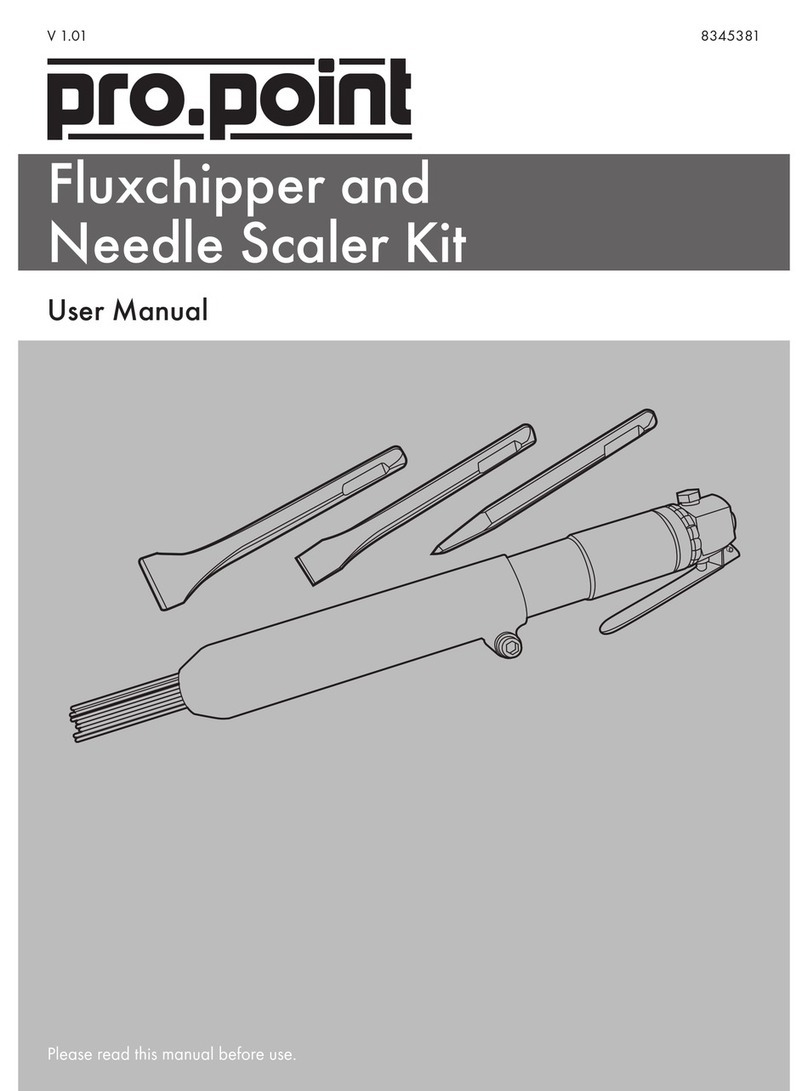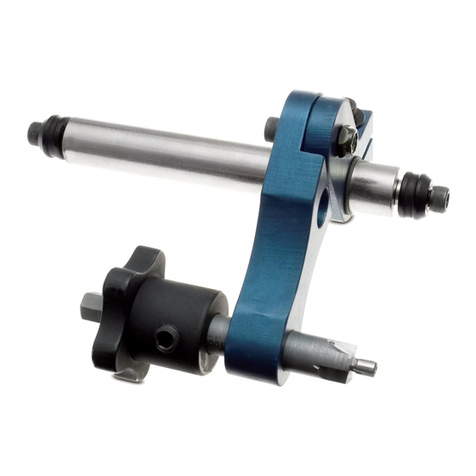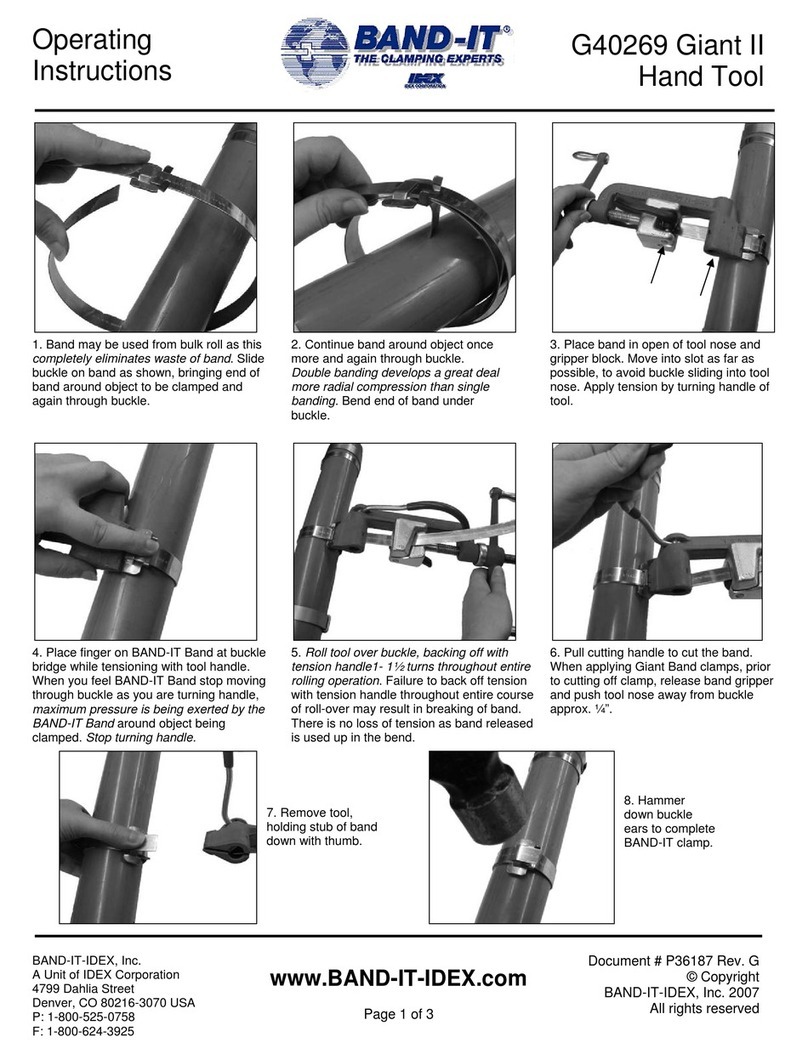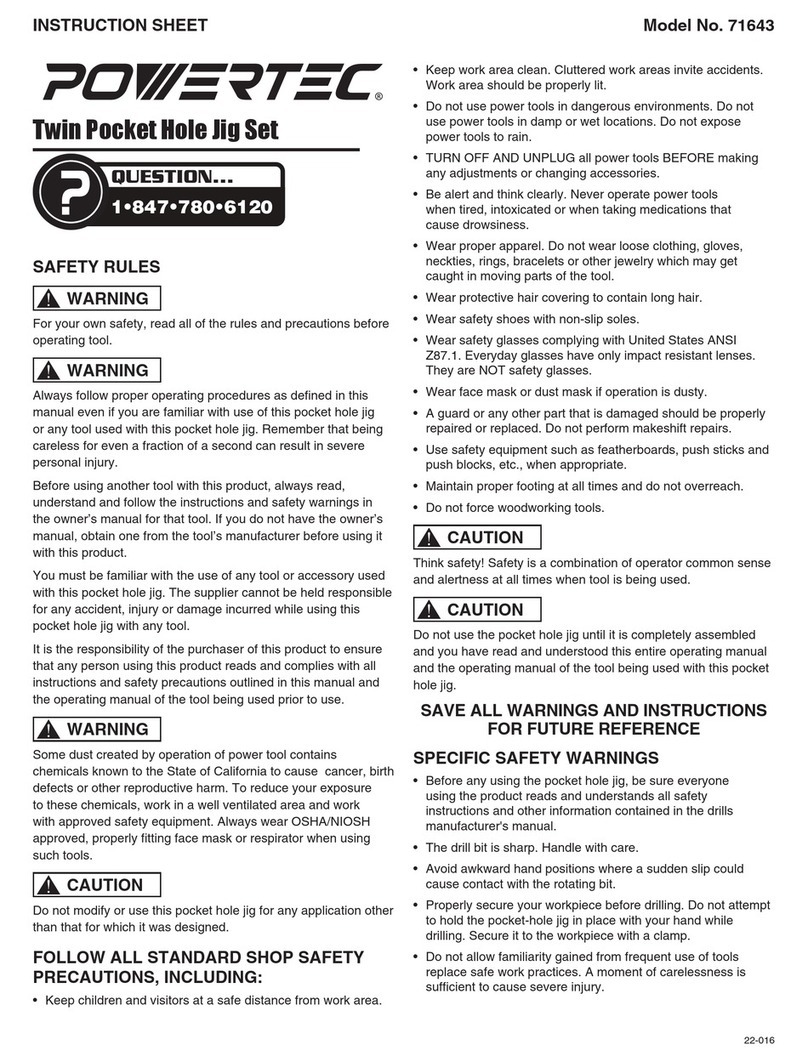Erbauer ERB709BTE User manual

ERB709BTE Original Instructions
ERBAUER 315MM THICKNESSER ERB709BTE
SAFETY AND OPERATING MANUAL
WARRANTY
YEARS

ERBAUER 315MM THICKNESSER ERB709BTE

ERBAUER 315MM THICKNESSER ERB709BTE
GUARANTEE
This product carries a guarantee of 24 months. If your product develops
a fault within this period, you should in the first instance contact the retailer where
the item was purchased.
This guarantee specifically excludes losses caused due to:
- Fair wear and tear
- Misuse or abuse
- Lack of routine maintenance
- Failure of consumable items (such as batteries)
- Accidental damage
- Cosmetic damage
- Failure to follow manufacturer’s guidelines
- Loss of use of the goods
This guarantee does not affect your statutory rights. This guarantee is only valid
in the UK.
For further technical advice, spare parts or repair service (outside of guarantee)
please contact your retailer quoting your Erbauer model number
Congratulations on your purchase of a quality power tool from Erbauer (UK)
Ltd. This product should give you reliable service but for your peace of mind
this power tool does carries a 24-month guarantee, the terms of
which are detailed below.
If this product develops a fault within the guarantee period contact your
retailer.
Please retain this handbook in case you need to refer to safety, care
or guarantee information in the future.

GENERAL SAFETY INSTRUCTIONS
WARNING! To ensure safe operation when using your Belt & Disc Sander, make
sure you follow basic safety principles to reduce risk of personal injury, electric
shock and fire. Please read the following instructions prior to operating this product
and keep for future use.
SAVE THESE INSTRUCTIONS
1. Keep the work area clean.
- Cluttered and dark areas invite accidents.
2. Consider work area environment.
- Do not expose power tools to rain. Do not use power tools in damp or
wet locations. Keep the work area well lit. Do not use tools in the presence of
flammable liquids or gases.
3. Guard against electric shock.
- Avoid body contact with earthed or grounded surfaces (e.g. pipes, radiators,
ranges, refrigerators).
4. Keep children away.
- Do not let persons, especially children, not involved in the work touch the tool
or the extension cord and keep them away from the work area.
5. Store idle tools.
- When not in use, tools should be stored in a dry, high or locked up place, out
of reach of children.
6. Do not force the tool.
- It will do the job better and safer at the rate for which it was intended.
7. Use the right tool.
- Do not force small tools to do the job of a heavy-duty tool. Do not use tools for
purposes not intended, for example, do not use circular saws to cut tree limbs
or logs.
8. Dress properly.
- Do not wear loose clothing or jewellery, they can be caught in moving parts.
Non-skid footwear are recommended when working outdoors. Wear protective
hair covering to contain long hair.
9. Use protective equipment.
- Use safety glasses. Use face or dust mask if working operations create dust.
10. Connect dust extraction equipment.
- If the tool is provided for the connection of dust extraction and collecting
equipment, ensure these are connected and properly used.
11. Do not abuse the cord.
- Never yank the tool to disconnect it from the socket. Keep the cord away from
heat, oil and sharp edges.
ERBAUER 315MM THICKNESSER ERB709BTE

ERBAUER 315MM THICKNESSER ERB709BTE
12. Secure work.
- Where possible use clamps or a vice to hold the work. It is safer than using your
hand.
13. Do not overreach.
- Keep proper footing and balance at all times.
14. Maintain tool with care.
- Keep cutting tools sharp and clean for better and safer performance. Follow
instructions for lubrication and changing accessories. Inspect tool cord periodically
and if damaged have them replaced by an authorised service facility. Inspect
extension cords periodically and replace if damaged. Keep handles dry, clean and
free of oil or grease.
15. Disconnect tools.
- When not in use, before servicing and when changing accessories such as blades,
bits and cutters, disconnect tools from the power supply.
16. Remove adjusting keys and wrenches.
- From the habit of checking to see that keys and adjusting wrenches are removed
from the tool before turning it on.
17. Avoid unintentional starting.
- Ensure switch is in the “off” when plugging in.
18. Use outdoor extension leads.
- When tool is used outdoors, use only extension cords intended for outdoor use
and so marked.
19. Stay alert.
- Watch what you are doing. Use common sense. Do not operate tool when you are
tired.
20. Check damaged parts.
- Before further use of the tool, it should be carefully checked to determine that it
will operate properly and perform its intended function. Check for alignment of
moving parts, binding of moving parts, breakage of parts, mounting and any
other conditions that may affect its operation. A guard or other part that is damaged
should be properly repaired or replaced by an authorised service centre unless
otherwise indicated in this instruction manual. Have defective switches replaced
by an authorised service facility. Do not use the tool if the switch dose not turn it
on and off.
21. Warning.
- The using of any accessory or attachment other than those recommended in this
instruction manual may present a risk of personal injury.
22. Have your tools repaired by qualified person.
- This electrical tool complies with the relevant safety requirements. Repairs should
only be carried out by qualified persons using original spare parts, otherwise this
may result in considerable danger to the user.

ERBAUER 315MM THICKNESSER ERB709BTE
HEALTH ADVICE
WARNING! When drilling, sanding, sawing or grinding, dust particles will be
produced. In some instances, depending on the materials you are working with,
this dust can be particularly harmful to you (e.g. lead from old gloss paint).
You are advised to consider the risks associated with the materials you are working
with and to reduce the risk of exposure. You should:
- Work in a well-ventilated area.
- Work with approved safety equipment, such as those dust masks that are specially
designed to filter microscopic particles.
ADDITIONAL SAFETY INSTRUCTIONS FOR YOUR TOOLS
- Always wear eye protection when operating any machine.
- Before starting up, check to make sure all holding screws are tight.
- Always stop motor and disconnect from power source before making any adjustments.
- Be sure all guards are in place before operating equipment.
- Read operator’s manual thoroughly and familiarize yourself with machine before
attempting to operate.
- Do not force work through the machine. Allow the planer to apply the proper feed
rate.
- Check feed rollers occasionally to be sure chips and sawdust are not lodged between
any components. If rollers are not seated firmly, the feed rolls will not hold stock firmly
against the bed, allowing kickback.
- Only plane wood boards.
- Use sound timber, with no loose knots and as few tight knots as possible.
- Never stand directly in line with either the infeed or outfeed sides. Always stand off
to one side of the machine.
- Make sure the workpiece is free of from nails, screws stones and other foreign objects
which could damage the blades.
- Make sure the blades are attached correctly as described in the instructions.
- Use caution when handling the blades and cutterhead assembly. The blades are sharp
and can easily cut your hand.
- Allow the cutterhead to reach full speed before using.
- Never use machine without correctly mounted and adjusted protective covers.
- Never use blunt planing irons as this increases risk of kickback.
- The parts of the cutting steel not in use should be covered.
- When planing shorter pieces a pusher should be used.
- When planing narrow pieces further precautions need to be taken to insure safe work,
such as appliances for pushing the work piece from above and spring loaded
protection.
- Planes may not be used for folding, milling, making marks or pegs.

ERBAUER 315MM THICKNESSER ERB709BTE
SYMBOLS
On the product, the rating label and within these instructions you will find among
others the following symbols and abbreviations.
Familiarise yourself with them to reduce hazards like personal injuries and damage to
property.
V~
W
m/min
min-1
yyWxx
Volt
Input power
Metres per minute
Per minute
Manufacturing date code; year of manufacturing (20yy) and week of
manufacturing (Wxx);
Hz
kg
dB (A)
Hertz
Kilogram
Decibel (A-rated)
Caution / Warning.
Read the instruction manual.
Wear gloves.
Keep hands away from
cutter head.
Wear hearing protection.
Wear eye protection.
Wear respiratory protection.
The product complies with the applicable European directives and an evaluation
method of conformity for these directives was done.
Switch the product off and disconnect it from the power supply before assembly,
cleaning, adjustments, maintenance, storage and transportation.
WEEE symbol. Waste electrical products should not be disposed of with
household waste. Please recycle where facilities exist. Check with your Local
Authority or local store for recycling advice.

ERBAUER 315MM THICKNESSER ERB709BTE
1. Support infeed roller
2. In-feed extension table
3. Table
4. Depth scale
5. Carbon brush cap
6. Cutter head adjustment handle
7. Storage compartment
8. Overload switch
9. ON/OFF switch
10. Roller knob
11. Dust port
12. Out-feed extension table
13. Support outfeed roller
14. Mounting hole
15. Dust extraction adapter
16. Carrying handle
7
11
16
8
10
9
12
13
6
4
5
3
2
1
15
14

ERBAUER 315MM THICKNESSER ERB709BTE
Input voltage
Power input
Min. cutting length
Max. cutting width
Max. cutting depth
Range of cutting depth
Feeding speed
Blade speed
Weight
230-240V~50Hz
1500W
127mm
315mm
2.5mm
5-153mm
8m/min
10000min-1
33kg
CARACTERISTIQUES TECHNIQUES
99.6dB(A)
112.6dB(A)
3dB(A)
A weighted sound pressure LpA
A weighted sound pressure LWA
Uncertainty
The sound intensity level for the operator may exceed 85dB(A) and sound protection
measures are necessary.
IMPORTANT NOTE
Remove the mains plug from socket before carrying out any adjustment or servicing.
Ensure your mains supply voltage is the same as your tool rating plate voltage.
NOISE

ERBAUER 315MM THICKNESSER ERB709BTE
YOU WILL NEED
(items not supplied)
14mm Open-end wrench
or adjustment wrench
Phillips screwdriver
(items supplied)
4mm, 5mm and 6mm Hex key (3pcs)
Knife alignment gauge (1pc)
8mm Open-end wrench (1pc)
UNPACKING
- Unpack all parts and lay them on a flat, stable surface.
- Remove all packing materials and shipping devices if applicable. Carefully lift the
machine from the the carton by the carry handles (16) on each side of the side cover
and place it on a level work surface.
WARNING! This tool is heavy.To avoid back injury, lift it while bending your legs,
not your back, and ask for assistance when need. The in-feed and out-feed
extension tables (2, 12) are attached to the thicknesser. Shipped in a folded, “upright”
position, the extension table must be in the “down” position before planing can begin.
- Make sure the delivery contents are complete and free of any damage. If you find that
parts are missing or show damage do not use the product but contact your dealer.
Using an incomplete or damaged product represents a hazard to people and property.
- Ensure that you have all the accessories and tools needed for assembly and operation.
This also includes suitable personal protective equipment.
The thicknesser is supplied with following accessories:
Thicknesser assembly
[17] x 01
Hexagon bolt
M6 x 20
[19] x 01
Hexagon bolt
M8 x 45
[21] x 04
Spring washer 6
[20] x 01
6mm Hex key
[22] x 01
5mm Hex key
[23] x 01
4mm Hex key
[24] x 01 Knife alignment gauge
[25] x 01
8mm Open-end wrench
[26] x 01
Cutter head
adjustment handle
[6] x 01
Dust port
[11] x 01
Dust extraction adapter
[15] x 01
Rubber foot
[18] x 04
ASSEMBLY INSTRUCTION

ERBAUER 315MM THICKNESSER ERB709BTE
WARNING! Do not connect to power supply
until assembly is complete. Failure to comply
could result in accidental starting and possible
serious injury.
SECURE TOOL TO WORKBENCH (Fig. 1)
The thicknesser features pre-drilled mounting holes
(14) on the base that allow mounting the tool to
the workbench.
If you choose to permanently mount your planer
to the workbench, use the four pre-drilled mounting
holes on the base.
- Drill four holes all the way through the workbench.
- Lift the thicknesser base and attach a rubber foot
(18) to each corner of the thicknesser assembly
(17). Align the hole in each foot with the mounting
hole (14) on the thicknesser assembly.
- Carefully place the thicknesser assembly on the
top of the workbench and align mounting holes
on the base with the holes on the workbench.
- Insert one hexagon M8 x 45 (21) in each of four
holes and fasten with flat washers (27) (not included),
spring washers (28) (not included) and nuts (29)
(not included).
- Tighten the hexagon bolts with a 14mm open-end
wrench or adjustment wrenche (not included) and
6mm hex key (22).
You can also mount the thicknesser directly to the
workbench using the lag screws (not included).
INSTALLING THE CUTTER HEAD ADJUSTMENT
HANDLE (Fig. 2)
- Attach the cutter head adjustment handle (6) to
the thicknesser and fasten with a hexagon bolt
M6 x 20 (19) and a spring washer 6 (20).
- Tighten the hexagon bolt using 5mm hex key (23).
Fig. 1
18
21
14
27
29
28
19
20
6
17
Fig. 2

ERBAUER 315MM THICKNESSER ERB709BTE
INTALLING THE DUST EXTRACTION ADAPTER
AND DUST PORT (Fig. 3-5)
- Using the 4mm hex key (24), loosen three hexagon
bolts M5 x 12 (29) located at the rear of the cutter
head assembly and move the flat washers 5 (30)
away from the surface so that they are next to the
head of the bolts.
- Align three holes (31) on the top of dust extraction
adapter (15) with the tabs (32) on the top of rear
of the cutter head assembly. And at the same
time align the three notches (33) on the dust
extraction adapter with the three hexagon bolts.
- Push the extraction adapter down until the tabs
in place.
-Tighten three hexagone bolts that secure the dust
extraction to the rear of the cutter head assembly.
- Attach the dust port (11) to the dust extraction
adapter (15).
To prevent sawdust bulidup, for best result, attach
a vacuum hose (not included) to the dust port. Do
NOT operate the saw with hose in place unless the
vacuum is turned on.
WARNING! Dust extraction adapter must
be fitted and the thicknesser must regularly
check for dust build up and cleaned frequently,
otherwise there is a risk of heat built up and
potential fire.
Fig. 3
29 30
32
Fig. 4
30
31
29
33
Fig. 5
11
15

ERBAUER 315MM THICKNESSER ERB709BTE
GETTING STARTED
- With the ON/OFF switch in the OFF position, lower
the cutter head to about 25.4 mm from the table.
Set the ON/OFF switch to the ON position. Allow
the thicknesser to reach its full speed.
Fig. 6
OPERATION INSTRUCTION
BEFORE YOUR START
This thicknesser finishes rough-cut lumber to size
and planes soft and hardwoods up to 153 mm thick
and 315 mm wide.
Any piece of wood will have a natural tendency to
bow and warp, even if it was initially milled perfectly
straight. This planer features a powerful 1500W
motor with overload protection and high carbon
steel knives to handle such tough cutting jobs.
Intended for use by the Do-It-Yourself enthusiast,
for wood working projects at home and in the
workshop.
THIS TOOL IS INTENDED FOR
- Surface planing (smoothing a rough lumber)
-Thickness planing (reducing the thickness of a
board)
SWITCH ON/OFF (Fig. 6)
- Open the switch guard (34) of the ON/OFF switch.
- To start the machine, press the ON/OFF switch (9)
to ON position (“I”).
- To stop, press the switch to OFF position (“O”).
- Close the switch guard.
CIRCUIT OVERLOAD SWITCH (Fig. 6)
This tool is equipped with an overload circuit
protection (35). If an overload occurs, the circuit
overload switch (35) cuts the power supply and
pops out. Should this occur:
- Set the On/Off switch to the Off position.
- Unplug the power cord from the power source
and wait several minutes until the tool cools
down.
- Remove the workpiece, if present.
- Plug in the power cord again.
- Press the circuit overload switch (35) and resume
operation.
34
35
9

ERBAUER 315MM THICKNESSER ERB709BTE
- If any excessive vibration is detected, switch the
thicknesser off and unplug it from the power
source. Check for any loose parts.Tighten or make
adjustments if necessary. Do not operate the
thicknesser until it is running smoothly and
without any vibrations.
CAUTION! Before starting, check for loose
fasteners or hardware. Make sure the cutter
head knife guard is securely mounted and the cutter
head rotates freely.
STOCK
Thickness
Width
Length
Depth of cut
MINIMUM
5mm
19mm
203mm
MAXIMUM
153mm
315mm
Unlimited
2.5mm
PLANING SPECIFICATIONS
- Do not plane lumber or wood that is contaminated
with metal, paint, dirt, water, or moisture from
tree sap, or wood that is severely bowed, warped
or twisted.
CAUTION! Plane selected lumber or wood
that has a minimum number of tight knots.
Wood with too many knots or loose knots has a
tendency to cause premature wear on the cutter
head knife, and increases the risk of unsafe
operation.
- Practise on a piece of scrap material first in order
to become familiar with the type of wood you are
planing. Take into consideration the hardness,
grain pattern, dryness and straightness of the
lumber or wood.
WORKPIECE LIMITATIONS
PLANING TIPS
-The thicknesser automatically feeds the workpiece
into and out of the cutter head. Do not force the
thicknesser to work faster than the designated
cutting speed. Damage to the workpiece and
thicknesser can result.
-The thicknesser works best if at least one side of
the workpiece is flat. If both sides are rough, the

ERBAUER 315MM THICKNESSER ERB709BTE
Fig. 7
thicknesser should be used to create one flat side
first. Plane the opposite side after one side is flat
and smooth.
- Planing should be carried out in steps in order to
achieve the final planing thickness. If the thickness
is to be reduced by 6 mm, then 3 mm should be
removed from each side. This also allows the
planed workpiece to dry and cure uniformly.
- Measure the thickest part of the workpiece that is
being planed. Make light cuts on both sides.
- Do not attempt to make a deep cut or a cut that
is deeper than 2.5 mm. Make several passes until
the desired thickness is achieved. Light cuts create
a finer finish.
- Avoid snipe or depressions made by the cutter
head knives at the beginning or end of the
workpiece by supporting both ends evenly. Keep
the board level during the entire planing operation.
-The knives on the thicknesser will not wear evenly
if the wood is fed through the same spot on the
table every time. Feed the wood through the
thicknesser at different spots on the table when
possible to help eliminate uneven wear of the
knives.
FEEDING THE WORKPIECE (Fig. 7)
- Always feed the workpiece with the grain, if
possible. If the workpiece must be fed against the
grain, make very light cuts.
- Hold the workpiece down firmly along the
workpiece guides and allow the thicknesser to
automatically feed the workpiece into the cutter
head.
WORKPIECE SUPPORT (Fig. 8)
Proper workpiece support prevents sagging or snipe
in the workpiece during planing. Make sure the
workpiece is supported along its entire length. If
necessary, extend the length of the in-feed/out-feed
extension tables (2, 12) in order to support the
workpiece:
- Loosen the in-feed/out-feed roller knobs (10).
- Pull the support infeed roller (1)/support outfeed
roller (13) out to the desired length.
Cutting direction
Planing against the grain
Planing with the grain

7
6
5
4
3
2
1
00
10
20
30
40
50
60
70
80
90
100
110
120
130
140
150
160
170
180
in/po mm
UP
DOWN
3/64
1.2
1/16
1.6
1/64
0.4
1/32
0.8
in
mm
0
ERBAUER 315MM THICKNESSER ERB709BTE
-Tighten the roller knobs (10) to secure the in-feed/
out-feed table extensions.
IMPORTANT! If an additional support is
needed for the workpiece, place supports on
both ends of the thicknesser, or install the thicknesser
at a depth where the planing surface is level with
the workbench. The supports must be at the same
height as the in-feed/out-feed extension tables
(2, 12), or the depth of installation must be such
that the workbench is at the same height as the
thicknesser.
SETTING THE PLANING DEPTH (Fig. 9)
Measure the workpiece at its thickest point. Use the
depth scale (4) at the in-feed side of the planer to
approximate the starting point of the first pass.The
first attempt at planing is intended to brush the
surface.
It is good practice to measure the workpiece after
every planing operation.
- Set the On/Off switch to the On position.
- Slowly guide the workpiece (36) along the
workpiece guides into the planer. After the cutter
head contacts the workpiece, pull the workpiece
out and raise the cutter head using the cutter
head adjustment handle (6).
- Repeat step 2 in 3 mm of a turn or less in order
to lower the cutter head until it just brushes the
surface of the workpiece. This establishes the
starting point for the next cutting pass.
- Use the adjustment scale to fine-tune the depth
of planing. One revolution of the cutter head
adjustment handle (6) moves the cutter head up
or down 1.6 mm.
IMPORTANT! Planing should be done in
steps in order to achieve the final planing
thickness. If the thickness is to be reduced by
6 mm, then 3 mm should be removed from each
side. Measure the workpiece after every planing
operation.
Fig. 9
Adjustment scale
Fig. 8
4
6
1
2
13
10
12
36

ERBAUER 315MM THICKNESSER ERB709BTE
WARNING! To ensure safety and reliability,
all repairs should be performed by a qualified.
service technician.
WARNING! When servicing, use only
identical replacement parts. The use of any
other parts may create a hazard or cause damage
to the tool.
WARNING! TO AVOID INJURY FROM
UNEXPECTED STARTING OR ELECTRIC
SHOCK unplug the tool from the power supply
before cleaning or performing any maintenance.
GENERAL MAINTENANCE
Periodic maintenance allows for long life and
trouble-free operation. Cleaning, lubrication and
maintenance schedules should be maintained. As
a common preventative maintenance practice,
follow the recommended steps below:
- Clean the tool to allow smooth functioning after
each use.The tool may be cleaned most effectively
with compressed dry air. Always wear safety
goggles when cleaning tools with compressed air.
- Ventilation openings must be kept clean and free
of foreign matter. Do not attempt to clean by
inserting pointed objects through openings.
- Check all electrical wires and connections for
damage.
- Keep motor air openings free of oil, grease and
sawdust or wood-chips.
- Check if all moving parts are well lubricated with
silicone or a light oil spray, especially after lengthy
exposure to damp and/or dirty conditions.
- Check for loose screws, alignment of moving parts
or binding of moving parts, breakage of parts,
mounting or any other condition that my affect
the operation.
- Inspect the feed rollers after each use. Resin and
tar may build up. Use clean cloth to clean the
rollers.
- Avoid using solvents when cleaning plastic parts.
Most plastics are susceptible to damage from
various types of commercial solvents and may be
damaged by their use. Use clean cloth to remove
dirt, carbon dust, etc.
MAINTENANCE

Cutter head side view
ERBAUER 315MM THICKNESSER ERB709BTE
WARNING! If the knives are to be removed
for sharpening or replacement, extreme care
should be taken, as the knives are very sharp.
REPLACING CUTTER HEAD KNIVES AND
CLEANING (Fig. 10-15)
This tool only use the knife size: 319 x 18.2 x 3.2mm.
CUTTER HEAD GUARD (Fig. 10-11)
- Raise the cutter head to the highest position using
the cutter head adjustment handle (6).
- Remove the cutter head adjustment handle (6) by
using 5mm hex key (23) to loosen the hexagon
bolt M6 x 20 (19) and the spring washer 6 (20).
- Loosen the four hexagon bolts (39) using the 6mm
hex key (22). Remove the top cover (37) and side
covers (38).
- Remove the dust extraction adapter (15) in reverse
order from what is described in the section
“INSTALLINGTHE DUST EXTRACTION ADAPTER
AND DUST PORT”.
- Use a clean cloth to wipe away any build-up of
debris from underneath the cover and the guard.
- Use penetrating oil (not included) to clean all
moving parts and the depth adjustment screws.
Apply a light coat of medium weight oil after
clean-up. Apply a light coat of paste wax to the
table, in-feed and out-feed extension table surfaces.
Do not use too much wax; it can hinder the
planing and stain the workpiece.
KNIFE REMOVAL (Fig. 12-13)
- Rotate the cutter head at the pulley so that one
knife is facing up.
- Loosen the knife anchor screws by turning them
in a clockwise direction.
- Carefully remove the knife.
Fig. 12
Knife anchor
screw
Knife anchor
screw
Knife
anchor
Knife
Fig. 13
Fig. 10
39
620
37
38
19
Fig. 11
15

ERBAUER 315MM THICKNESSER ERB709BTE
KNIFE INSTALLATION (Fig. 14)
IMPORTANT: Clean the knives regularly.
Gum and pitch collects on knives, and causes
excess friction during operation.The knives may
overheat and wear. Remove the knives to clean and
use a gum/pitch remover available in specialized
retail shops.
- Carefully place the knife back in the cutter head.
Make sure that the spring is in place.
- Place the knife alignment gauge (25) on the cutter
head, with the lobe making contact with the edge
of the knife.
- Apply light pressure on the knife alignment gauge
and make sure the knife and knife anchor are
centered in the cutter head.
IMPORTANT: If the knives and anchors are
not centred in the cutter head, they will rub
against the cutter head carrier and the planer may
get damaged.
- While applying light pressure to the knife alignment
gauge, tighten the anchor screws by turning them
in a counter-clockwise direction, alternating from
one side to the other, starting from the outside
and working toward the inside.
- Reinstall the top and side covers, and make sure
the depth scale (on one of the side covers) is facing
the front.
- Clean the exterior of the planer with a clean, dry
cloth. Apply a light coat of paste wax in order to
ease cleaning and reduce dust build-up.
SHARPENING KNIVES (Fig. 15)
The knives can be sharpened individually with a
whetstone. Make sure the whetstone is not worn
in the centre - it must be flat. Make sure to remove
any burrs on the flat side. If the knives are nicked,
they must be replaced or reground. Knives can be
reground several times, until they become 14mm
wide. Have your knives reground by an experienced
person.
Fig. 14
Knife
Knife
anchor
screw
Knife
anchor
Spring
Fig. 15
25

Green &Yellow E(Earht)
Blue
(neutral)
N
13amp fuse
approved to
BS1362
Brown
(live)
L
Cable grip
Outer sleeve
13amp
ERBAUER 315MM THICKNESSER ERB709BTE
CARBON BRUSH REPLACEMENT (Fig. 16)
IMPORTANT! To maintain peak efficiency
of the motor, we recommend checking the
brushes after each 50 hours of use. Replace both
carbon brushes when either has less than 2mm
of carbon remaining, or if the spring or wire
is damaged or burned. Make sure to replace both
brushes at the same time even if only one is
damaged.
To inspect or replace the carbon brushes:
- Remove the brush cap (5) on the motor using a
wide, Phillips screwdriver (not included).
- Carefully pull out the spring-loaded brush
assemblies (40). Repeat for the opposite side of
the motor (behind the dust extraction adapter).
- Insert new brush assemblies into guide channels,
with the carbon part going in first. Make sure to
fit the two metal “ears” into their slots in the
channel.
- Remember to replace both end caps after inspecting
or the servicing brushes.Tighten the brush cap
but do not over tighten.
Fig. 17
Brush opening
Fig. 16
PLUG REPLACEMENT (Fig. 17)
If you need to replace the fitted plug then follow
the instructions below.
IMPORTANT: The wires in the mains lead
are coloured in accordance with the following
code:
Blue – Neutral
Brown – Live
Green/Yellow – Earth
As the colours of the wires in the mains lead
of this appliance may not correspond with the
coloured markings identifying the terminals in
your plug, proceed as follows.The wire, which is
coloured blue, must be connected to the terminal
which is marked with an N or coloured black.The
wire, which is coloured brown, must be connected
to the terminal which is marked with an L or
coloured red.The wire, which is coloured green/
yellow, must be connected to the remaining
terminal which is marked with an E or .
WARNING: Never connect live or neutral
wires to the earth terminal of the plug. Only
5
5
40
Table of contents
Other Erbauer Tools manuals
Popular Tools manuals by other brands

Blue Diamond
Blue Diamond EXTREME DUTY Series Operator's manual

Thomas&Betts
Thomas&Betts Stakon COMFORT CRIMP ERG4005 Instructions for use

FLORABEST
FLORABEST 280270 instructions
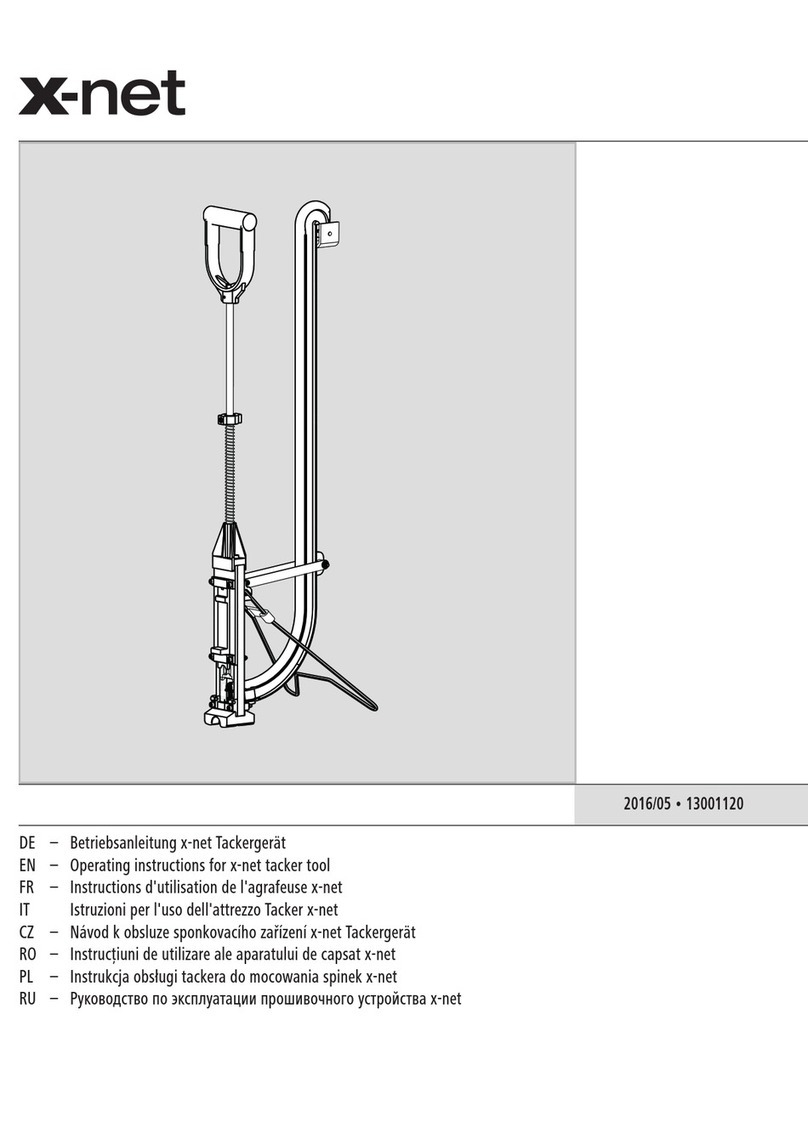
x-net
x-net C12 operating instructions
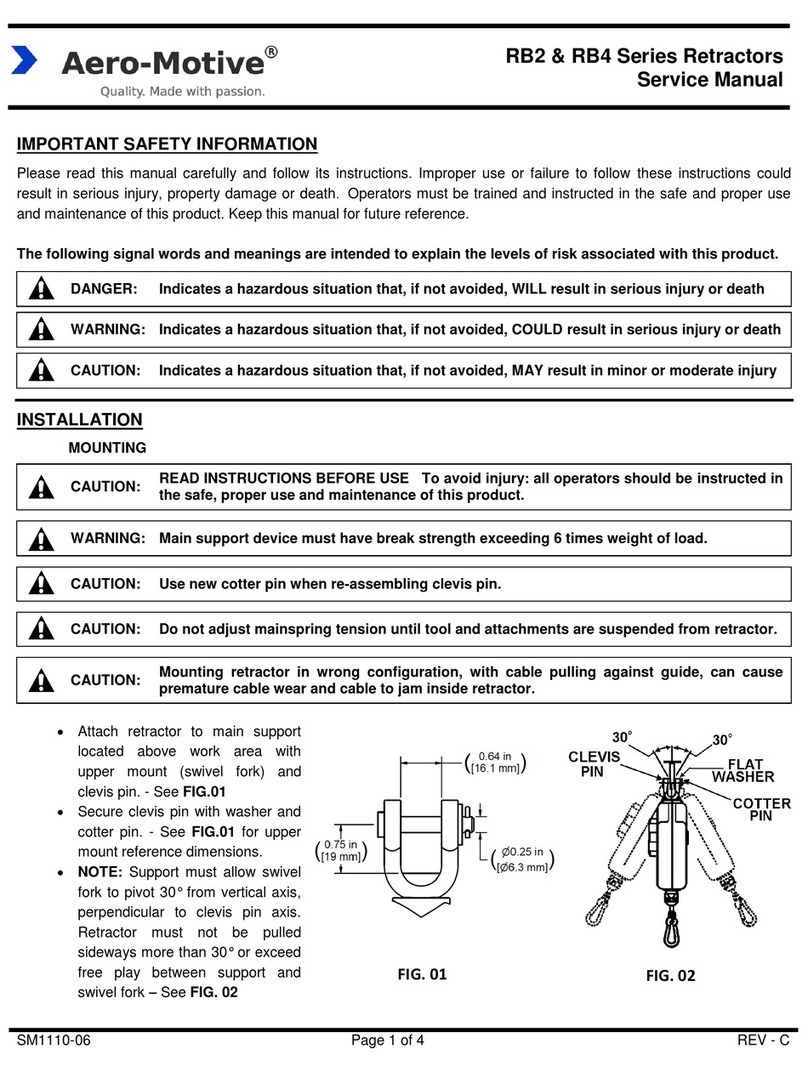
Aero-motive
Aero-motive RB2 Series Service manual

OEM Tools
OEM Tools 27407 Operating instructions and parts manual
